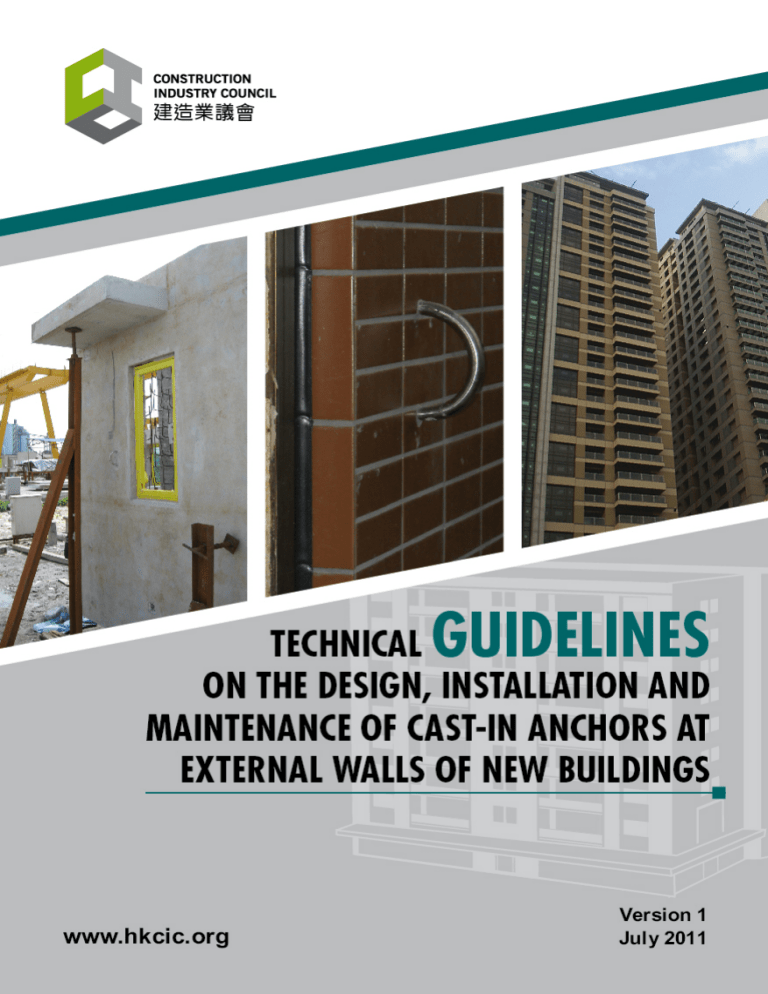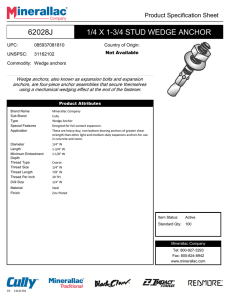
Disclaimer This publication is prepared by the Construction Industry Council (CIC) to report findings or promote good practices on specific subjects for reference by the industry. To the best of our knowledge, information contained in this publication reflects the latest legislation, policy and rules as per the date of publication. You are strongly advised to seek independent advice on any future legislation, policy and rules amendments where possible. This publication may become relevant before a court or tribunal to establish any alleged breach of a duty of care on the part of an industry stakeholder. However, it is NOT intended to constitute any professional advice on these or any other subjects. The CIC (including its members and employees) will NOT accept responsibilities for any consequences resulting from the use of or failure to use this publication. Enquiries Enquiries on these guidelines may be made to the CIC Secretariat at – 15/F, Allied Kajima Building 138 Gloucester Road, Wanchai Hong Kong Tel. No. : (852) 2100 9000 Fax. No. : (852) 2100 9090 E-mail enquiry@hkcic.org : Website : www.hkcic.org © 2011 All rights reserved by the CIC. 1 Table of Contents Preface ............................................................................................................... 3 1. Background ................................................................................................... 4 2. Location ......................................................................................................... 4 3. Technical Design........................................................................................... 5 4. Testing before Installation............................................................................ 6 5. Installation ..................................................................................................... 7 6. Testing after Installation............................................................................... 7 7. Operation / Maintenance............................................................................... 8 2 Preface The Construction Industry Council (CIC) is committed to seeking continuous improvement in all aspects of the construction industry in Hong Kong. To achieve this aim, the CIC forms Committees, Task Forces and other forums to review specific areas of work with the intention of producing Guidelines, Codes of Practice and Codes of Conduct to assist participants in the industry to strive for excellence. The CIC appreciates that some improvements and practices can be implemented immediately whilst others may take more time to complete the adjustment. It is for this reason that three separate categories of publication have been adopted, the purpose of which is as follows: Guidelines These are intended to guide industry participants to adopt new standards, methodologies or practices. The CIC strongly recommends the adoption of these Guidelines by industry stakeholders where appropriate. Codes of Practice The CIC expects all industry participants to adopt the recommendations set out in such Codes as soon as practicable and to adhere to such standards or procedures therein at all times. Codes of Conduct The CIC encourages the upholding of professionalism and integrity within the industry through self discipline. The Codes of Conduct set out the relevant principles that all industry participants are expected to follow. The parties adopting the practices set out in this publication will normally be considered by the CIC in general as adopting good practices (where relevant) on the specific subjects. The parties using this publication should therefore seek appropriate advice from their professional advisers. If you have attempted to follow this publication, we do urge you to share your feedback with us in order that we can further enhance them for the benefit of all concerned. On this basis the CIC Secretariat is in the process of developing a “feed-back” mechanism, whereby your views can be consolidated for such purposes. With our joint efforts, we believe our construction industry will develop further and will continue to prosper for years to come. 3 1. Background In view of the frequent accidents associated with repair, maintenance, alterations and additions (RMAA) works in existing buildings, the Committee on Construction Site Safety (Com-CSS) of the Construction Industry Council (CIC) considers that permanent safety features including gondola system, service platform and anchors should be recommended for installation at the external wall of all new buildings when they are constructed. These safety measures will enhance the safety of workers when carrying out future RMAA works at the external walls of the buildings, and minimise the occurrence of falling down of workers from a height. The Director of Buildings has in February 2010 issued PNAP ADV-14 advising Authorised Persons (AP) and Registered Structural Engineers (RSE) to install gondolas in new buildings to facilitate the external inspection and maintenance of buildings. With a view to providing further safety enhancements on carrying out external maintenance and repair works of existing buildings, the Com-CSS considers that AP and RSE should also be advised to provide cast–in anchor devices in the design and construction of new buildings. The anchors will provide for the direct attachment of personal fall protection systems and equipment for use of workers to prevent and/or arrest falls from height when working on the external walls of buildings during repair and maintenance works. This document presents the details of the technical guidelines for the location, design, installation and maintenance of such cast-in anchors. 2. Location The device is recommended to be installed at locations which cannot be reached by gondolas, if provided, and which require frequent inspection and maintenance such as light wells, and where drain pipes and air conditioning units are installed. 4 3. Technical Design Cast-in anchors should be positioned at the external walls with a minimum thickness of 125 mm or external structural elements of all new buildings in such a way that they are safely accessible and easily visible to workers when carrying out external repair and maintenance of existing buildings. They should in no case make the workers exposed to the risk of falling in the course of securing and detaching the anchorage. Labour Department may be consulted if there is any query on the position of the cast-in anchors. 5 The design life of the cast-in anchors should be the same as the design life of the building, and should be taken into consideration in the design of the anchors. The cast-in anchors should be installed at pre-determined locations during casting of the supporting structural elements. The anchor bars shall be of stainless steel with a minimum diameter of 16 mm for external applications. Designers may make reference to “Structural Design of Stainless Steel” – SCI publication P291 by N.R. Baddoo and BA Burgan (Published by The Steel Construction Limited), Concrete Society Technical Report 51 “Guidance on the Use of Stainless Steel Reinforcement” (Published by Concrete Society (UK)), BS 6744: 2001, etc. Cast-in anchors and their supporting structural elements shall be designed to sustain: (a) A static design load of 10 kN applied in which the force can be applied in service as required in BS EN 795: 1997; and (b) An equivalent static load resulted from allowing a 100 kg mass, fixed by a 12 mm diameter polyamide rope lanyard to the anchor, to fall freely through (2500 ± 50 ) mm when placed at 300 mm maximum horizontally from the anchor, as required in BS EN 795: 1997. Alternatively, the equivalent design static ultimate load can be taken as the minimum breaking force of 30.1 kN of the lanyard as specified in BS EN 1140: 2004. AP/RSE proposing to install the anchors in new buildings should submit structural details of the anchors and plans showing the supporting structural elements etc., together with structural calculations to the Buildings Department (BD) for approval. 4. Testing before Installation Mill certificates and test reports of the stainless steel bars are required to substantiate their material properties and specified strength of the rod. All tests should be carried out and certified by a laboratory accredited under the Hong Kong Laboratory Accreditation Scheme (HOKLAS) or by other laboratory accreditation bodies which have reached mutual recognition agreements/arrangements with HOKLAS, for the particular test concerned, and test reports should be submitted to and found satisfactory by the AP/RSE before installation. 6 5. Installation Cast-in anchors shall be properly installed to the external wall with a minimum thickness of 125mm or the structural elements of the building in accordance with relevant standards including the provision of adequate concrete cover and proper positioning of the stainless steel bars as specified in Concrete Society Technical Report 51 and relevant concrete code. 6. Testing after Installation OP STAGE No test is required for the cast-in anchors after installation. After the completion of works, the mill certificates and test reports of the stainless steel bars as required in Section 4 above should be submitted to the BD. They should be appended with a statement signed by the AP/RSE to confirm that the acceptance criteria appropriate to the types of steel bar used have been complied with. Upon application for Occupation Permit (OP) for the new building installed with anchor devices, AP/RSE and Registered General Building Contractor should submit Materials Schedule of Building Materials and Products (Appendix A of PNAP APP-13) to confirm the use of acceptable materials and products in the construction for BD’s record. 7 AFTER OP 7. Operation / Maintenance Upon the completion of a building and when handing over the building to the owner, AP/RSE should inform the concerned parties including building owners, owners’ corporations and management companies, on the following requirements as regards to the future proper use of the cast-in anchors: (a) Each cast-in anchor shall only be used by one worker at any one time; (b) Cast-in anchors shall be the connection point of the fall arrest equipment such that the worker will not fall more than the height specified by the specifications of the safety belt, nor contact any lower level structures. The distance of fall shall be minimized as far as practicable; (c) An annual inspection is required and shall be carried out by a Registered Professional Engineer in Building, Civil or Structural Disciplines. The inspection certificate so issued is valid for 12 months and should be made available for Labour Department’s inspection upon request; (d) Suitable type of lanyard and safety belt system shall be used. Reference can be made to “Guidance Notes on Classification and Use of Safety Belts and their Anchorage Systems” published by the Occupational Safety and Health Branch, Labour Department, and relevant British Standards; (e) The requirements stipulated by the Labour Department for using the anchor devices shall be included; (f) The cast-in anchors are one of the structural elements to be shown in the general building and structural plans submitted to the BD for approval and consent. Any alterations to the cast-in anchor shall also be submitted to the BD for approval and consent; (g) All inspection records of the anchors shall be properly maintained; and (h) If the cast-in anchors have been subjected to impact force or misused, they shall not be used again until inspected and determined by a Registered Professional Engineer in Building, Civil or Structural Disciplines, to be undamaged and suitable for reuse. 8



